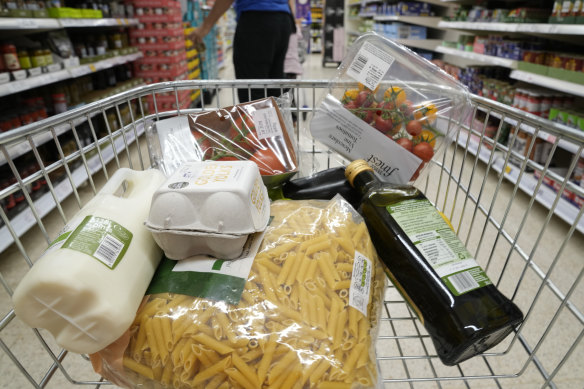Save articles for later
Add articles to your saved list and come back to them any time.
The Reserve Bank has reason to hold off inflicting more pain on mortgage holders next week after Australia recorded the smallest annual increase in inflation in more than a year.
Inflation rose by 5.6 per cent in the 12 months to May, down from 6.8 per cent the month before and well below the December peak of 8.4 per cent.
Inflation rose by 5.6 per cent in the 12 months to May.Credit: AP
After 12 interest rate rises since April last year, which have taken the official cash rate from 0.1 per cent to 4.1 per cent, some economists said the figures from the Australian Bureau of Statistics gives the Reserve Bank reason to hold off lifting rates at its next board meeting on July 4.
But continued price pressures for essentials, including housing and food, and fears inflation could remain high for too long mean there is a risk the central bank decides to lift interest rates as it works to get inflation back down to its target range of 2-3 per cent.
ABS head of price statistics Michelle Marquardt said the annual inflation increase of 5.6 per cent was the smallest rise since April 2022.
“While prices have kept rising for most goods and services, many increases were smaller than we have seen in recent months,” she said.
Callam Pickering, Asia-Pacific economist at jobs site Indeed said the inflation figures give the Reserve Bank room to pause rate rises.
“While the monthly inflation figures can be volatile, these figures reduce the likelihood of a July rate hike,” he said.
“Annual inflation is now at its lowest level since April last year. While still clearly too high, that’s a welcome development and a sign that tighter monetary policy is having the desired impact.”
The unexpectedly sharp drop in inflation suggests the end of interest rate rises is near, KPMG chief economist Brendan Rynne said, but core inflation remains stubbornly high.
“While today’s inflation data provides some comfort to the RBA as headline inflation and their preferred measure ‘trimmed mean inflation’ had come down significantly, the stickiness of core inflation may remain of concern,” he said.
“With an extremely tight labour market and the balance of risks tilted to the upside, the consideration of another rate rise remains on the table in the coming RBA meetings; however, now the probability of a pause in the July meeting has risen.”
The monthly inflation figures published are more affected by volatile price changes in goods such as holiday travel, fuel and fresh food.
When items with volatile price changes are excluded from the consumer price index, underlying annual inflation fell more modestly, from 6.5 per cent in April to 6.4 per cent in May.
Annual trimmed mean inflation, the measure closely watched by the Reserve Bank, fell to 6.1 per cent in May from 6.7 per cent in April.
EY Senior Economist Paula Gadsby said inflation remained too high particularly when volatile items were excluded. Consumers were also continuing to face rising costs for essentials such as rents, electricity and food.
“Persistent services inflation, along with subdued productivity growth driving a rapid rise in unit labour costs, will make the Reserve Bank very uncomfortable,” she said.
“This, combined with the strong labour market reading for May, strengthens the case for tighter monetary policy in coming months.”
ANZ economists also expect the Reserve Bank to continue lifting interest rates, in both July and August, but acknowledged there was the chance of a pause next week.
ANZ senior economist Adelaide Timbrell said other data could offset the positive news from lower inflation, including future electricity price increases and ongoing wage growth.
Rental inflation was 6.3 per cent in the 12 months to May, up from 6.1 per cent in April as the rental market remains tight. New home prices rose 8.3 per cent, the lowest annual growth rate since November 2021 as the cost of building materials has continued to ease.
Food and non-alcoholic drink prices rose 7.9 per cent in the same period, driven by increased prices in dining out and takeaway but also significantly affected by increases in bread and cereal products (up by 12.8 per cent) and dairy (up by 15.1 per cent).
Holiday travel and accommodation prices rose 7.3 per cent in the year to May, down from 11.9 per cent the month prior and continuing the fall from the December peak in prices.
In monthly terms, there was a large fall in travel and accommodation prices of 11.3 per cent in May after the strong demand driven by Easter and the April school holidays eased.
Automotive fuel prices fell 8 per cent in the year to May, after those prices rose 9.5 per cent in the year to April. Over the month of May fuel prices fell 6.7 per cent due to higher oil production and a strong Australian dollar, which lowered the cost of oil imports.
Most Viewed in Politics
From our partners
Source: Read Full Article



